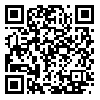Volume 11, Issue 2 (spring 2022)
Arch Hyg Sci 2022, 11(2): 147-154 |
Back to browse issues page
Download citation:
BibTeX | RIS | EndNote | Medlars | ProCite | Reference Manager | RefWorks
Send citation to:



BibTeX | RIS | EndNote | Medlars | ProCite | Reference Manager | RefWorks
Send citation to:
Mashkoori A, Allahdadi Z, Abedi S A, Dastjani Farahani S, Gharlipour Z, Koohpaei A, et al . Evaluation of Infrared Radiation and Occupational Cataracts in Bakeries in Qom Province, Iran. Arch Hyg Sci 2022; 11 (2) :147-154
URL: http://jhygiene.muq.ac.ir/article-1-371-en.html
URL: http://jhygiene.muq.ac.ir/article-1-371-en.html
Alireza Mashkoori1 

 , Zahra Allahdadi2
, Zahra Allahdadi2 

 , Seyed Abed Abedi1
, Seyed Abed Abedi1 

 , Shahab Dastjani Farahani1
, Shahab Dastjani Farahani1 

 , Zabiholah Gharlipour3
, Zabiholah Gharlipour3 

 , Alireza Koohpaei *
, Alireza Koohpaei * 

 1, Hassan Mohammadpour4
1, Hassan Mohammadpour4 

 , Hamidreza Gilasi5
, Hamidreza Gilasi5 




 , Zahra Allahdadi2
, Zahra Allahdadi2 

 , Seyed Abed Abedi1
, Seyed Abed Abedi1 

 , Shahab Dastjani Farahani1
, Shahab Dastjani Farahani1 

 , Zabiholah Gharlipour3
, Zabiholah Gharlipour3 

 , Alireza Koohpaei *
, Alireza Koohpaei * 

 1, Hassan Mohammadpour4
1, Hassan Mohammadpour4 

 , Hamidreza Gilasi5
, Hamidreza Gilasi5 


1- Department of Occupational Health Engineering, Faculty of Health, Qom University of Medical Sciences, Qom, Iran.
2- Research Center for Work Health, Qom University of Medical Sciences, Qom, Iran.
3- Department of Health Education and Promotion, Faculty of Health, Qom University of Medical Sciences, Qom, Iran.
4- Occupational Health Executive, Vice Chancellor for Health, Qom University of Medical Sciences, Qom, Iran.
5- Department of Biostatistics and Epidemiology, Faculty of Health, Kashan University of Medical Sciences, Kashan, Iran.
2- Research Center for Work Health, Qom University of Medical Sciences, Qom, Iran.
3- Department of Health Education and Promotion, Faculty of Health, Qom University of Medical Sciences, Qom, Iran.
4- Occupational Health Executive, Vice Chancellor for Health, Qom University of Medical Sciences, Qom, Iran.
5- Department of Biostatistics and Epidemiology, Faculty of Health, Kashan University of Medical Sciences, Kashan, Iran.
Abstract: (1182 Views)
Background & Aims of the Study: Nowadays, ionizing and non-ionizing radiation seems to have a vital role in all aspects of human life. However, radiations such as infrared radiation (IR) adversely affect the human visual system. This study aimed to evaluate IR exposure and occupational cataracts in the selected traditional and automatic bakeries in Qom Province, Iran.
Materials and Methods: This cross-sectional study was conducted in traditional and modern bakeries with 306 workers. Demographic data were collected using a demographic questionnaire. IR measurement was done using the Hagner EC1-IR digital radiometer at the eye height and in the first and last hours of the workday. The obtained data were analyzed with statistical tests of the Chi-square, Fisher exact, 1-way ANOVA, and independent t test in SPSS software v. 20.
Results: According to the obtained results, 16.1% of the workstations had a high level of exposure to IR, and 20.3% of workers were suffering from cataracts. The results showed a significant correlation between the exposure level and jobs as well as tasks and working hours (P<0.05). Also, a significant correlation was observed between the risk of cataracts and the exposure level, workstation type, age, and experience (P<0.05). However, no significant difference was observed between the type of bakeries and the risk of cataracts (P=0.59).
Conclusion: Based on our findings, nearly one-sixth of the surveyed stations were higher than the standard limit in terms of IR measurement, and nearly one-fifth of workers were suffering from cataracts. The results indicated that due to the long-term exposure of bakery workers to IR, it is necessary to plan and implement effective control measures in bakeries.
Materials and Methods: This cross-sectional study was conducted in traditional and modern bakeries with 306 workers. Demographic data were collected using a demographic questionnaire. IR measurement was done using the Hagner EC1-IR digital radiometer at the eye height and in the first and last hours of the workday. The obtained data were analyzed with statistical tests of the Chi-square, Fisher exact, 1-way ANOVA, and independent t test in SPSS software v. 20.
Results: According to the obtained results, 16.1% of the workstations had a high level of exposure to IR, and 20.3% of workers were suffering from cataracts. The results showed a significant correlation between the exposure level and jobs as well as tasks and working hours (P<0.05). Also, a significant correlation was observed between the risk of cataracts and the exposure level, workstation type, age, and experience (P<0.05). However, no significant difference was observed between the type of bakeries and the risk of cataracts (P=0.59).
Conclusion: Based on our findings, nearly one-sixth of the surveyed stations were higher than the standard limit in terms of IR measurement, and nearly one-fifth of workers were suffering from cataracts. The results indicated that due to the long-term exposure of bakery workers to IR, it is necessary to plan and implement effective control measures in bakeries.
Keywords: Infrared Rays, Cataracs, Bakery workers, Occupational Groups, Occupational exposure, Iran, Qom
Type of Study: Original Article |
Subject:
Occuptional Health
Received: 2021/08/11 | Accepted: 2021/09/14 | Published: 2022/07/1
Received: 2021/08/11 | Accepted: 2021/09/14 | Published: 2022/07/1
Send email to the article author
| Rights and permissions | |
 |
This work is licensed under a Creative Commons Attribution-NonCommercial 4.0 International License. |







